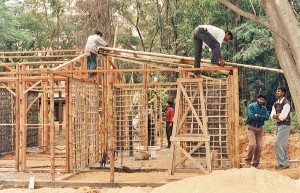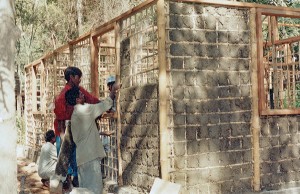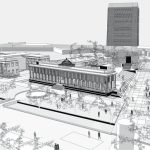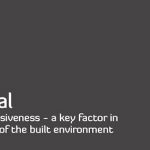-
Bamboo in Construction
October 2010
By Lionel Jayanetti
Bamboo has a long history as a building material. It is widely used in construction throughout the world’s tropical and sub-tropical regions, with a range of applications to match or even exceed those of timber. In Central and South America, bamboo buildings of every description can be found – from low-grade temporary housing to exclusive, architect designed mansions

Bamboo is the fastest growing woody plant on the planet, but it actually belongs to the grass family. Most species produce mature fibre in about three years, much faster than any tree species. Some species grow up to one metre a day, with the majority reaching a height of 30 metres or more.
Bamboo has exemplary ‘green’ credentials. It is adaptable to most climatic conditions and soil types, acting as an effective carbon sink and helping to counter the greenhouse effect. It is finding increasing use in land stabilisation, to check erosion and conserve soil. It can be grown quickly and easily – even on degraded land – and harvested sustainably on three to five year rotation. Bamboo is a truly renewable, environmentally friendly material.
Perhaps the major factor contributing to the view of bamboo as a temporary material is its lack of natural durability. Bamboo is susceptible to attack by insects and fungi, and its service life may be as low as one year when in ground contact. However, the durability of bamboo can be greatly enhanced by appropriate specification and design, and by the careful use of safe and environmentally friendly preservatives such as boron.
The main structural advantages of bamboo – its strength and light weight – mean that properly constructed bamboo buildings are inherently resistant to wind and earthquake forces. These properties can be effectively exploited through
careful yet simple design and detailing.
Bamboo products for use in construction are increasing in availability. These range from bamboo mat boards (flat and corrugated), through more sophisticated panel products such as fibreboard, ‘plyboo’ and flooring, to large laminated sections (currently under development) for use in external joinery.

Bamboo use is not restricted to building. Bamboo has been used as concrete reinforcement, and development work is continuing in this field. Bamboo is used for light traffic bridges, and the feasibility of constructing large span bridges carrying vehicular traffic has recently been demonstrated in Colombia. Bamboo as scaffolding is well known (40 storey construction is not uncommon in the Far East), and its use is set to increase as a result of the development of a design and erection guide in Hong Kong.
Other construction applications include ground stabilisation, through the use of retaining walls and piling, and coastal protection (recently trialled in Sri Lanka).
In order to promote the use of bamboo in construction, a design competition was initiated by the GTZ project and conducted by the Department of Architecture of the University of Moratuwa. Entries were invited from final year and postgraduate students to design a road side café and a model house for a low/ middle income family. The winning designs were reported in the Sri Lanka Institute of Architects journal “The Architect” Vol 109 no 3.
Components























